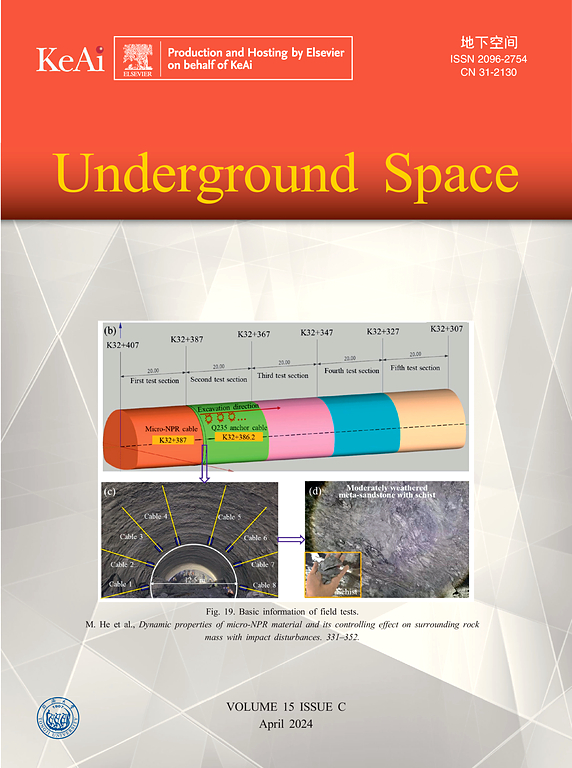Non-parametric probabilistic seismic capacity model for the stochastic interaction system of soil-subway station structures
IF 8.3
1区 工程技术
Q1 ENGINEERING, CIVIL
引用次数: 0
Abstract
A reasonable seismic capacity model is crucial for establishing the seismic performance level system and evaluating the seismic reliability of subway station structures. However, the deterministic structural and geotechnical mechanical parameters are usually applied to calibrate the seismic performance levels of subway station structures in the traditional seismic capacity analysis, which ignores the stochasticity of the soil-subway station interaction system. To overcome the challenge caused by the stochastic interaction system, the probability space partition method and stochastic pushover analysis method are combined to develop a calibration strategy of seismic performance levels considering the complete probabilistic information of the stochastic interaction system, and the non-parametric probabilistic seismic capacity models of the subway station structure are further established based on the principle of probability conservation in this paper. A subway station is also taken as the prototype to investigate the applicability of the proposed strategy and the influence of system randomness on the seismic capacity of the subway station structure. The results demonstrate that the seismic performance levels calibrated according to the proposed strategy can effectively consider the complete probabilistic information of the interaction system, which are more rigorous than the existing performance levels. Meanwhile, the probability density evolution of the bearing capacity of the subway station structure is essentially a non-stationary stochastic process, and the non-parametric probability density curves of seismic capacity display noticeable multi-peak characteristic. Moreover, the seismic capacity for LP1 and LP2 levels is more sensitive to the variability of geotechnical parameters above and below the structure, while the former for LP3 and LP4 levels is more sensitive to that on both sides of the structure. The relevant conclusions can provide some guidance for seismic design and improvement of the performance limits of underground structures in the related codes.
土-地铁车站结构随机相互作用体系的非参数概率抗震能力模型
合理的抗震能力模型是建立地铁车站结构抗震性能等级体系和评价其抗震可靠度的关键。然而,在传统的抗震能力分析中,通常采用确定性的结构和岩土力学参数来标定地铁车站结构的抗震性能水平,忽略了土-地铁车站相互作用体系的随机性。为克服随机相互作用系统带来的挑战,结合概率空间划分法和随机推覆分析法,建立了考虑随机相互作用系统完全概率信息的抗震性能等级标定策略,并基于概率守恒原理建立了地铁车站结构的非参数概率抗震能力模型。并以某地铁车站为原型,研究了该策略的适用性以及系统随机性对地铁车站结构抗震能力的影响。结果表明,根据该策略标定的抗震性能等级能有效地考虑相互作用体系的完整概率信息,比现有的性能等级更为严格。同时,地铁车站结构承载力的概率密度演化本质上是一个非平稳的随机过程,抗震能力的非参数概率密度曲线表现出明显的多峰特征。LP1和LP2水平的地震能力对结构上方和下方岩土参数的变化更为敏感,而LP3和LP4水平的地震能力对结构两侧岩土参数的变化更为敏感。相关结论可为相关规范中地下结构抗震设计和性能限值的提高提供一定的指导。
本文章由计算机程序翻译,如有差异,请以英文原文为准。
求助全文
约1分钟内获得全文
求助全文
来源期刊

Underground Space
ENGINEERING, CIVIL-
CiteScore
10.20
自引率
14.10%
发文量
71
审稿时长
63 days
期刊介绍:
Underground Space is an open access international journal without article processing charges (APC) committed to serving as a scientific forum for researchers and practitioners in the field of underground engineering. The journal welcomes manuscripts that deal with original theories, methods, technologies, and important applications throughout the life-cycle of underground projects, including planning, design, operation and maintenance, disaster prevention, and demolition. The journal is particularly interested in manuscripts related to the latest development of smart underground engineering from the perspectives of resilience, resources saving, environmental friendliness, humanity, and artificial intelligence. The manuscripts are expected to have significant innovation and potential impact in the field of underground engineering, and should have clear association with or application in underground projects.
 求助内容:
求助内容: 应助结果提醒方式:
应助结果提醒方式:


